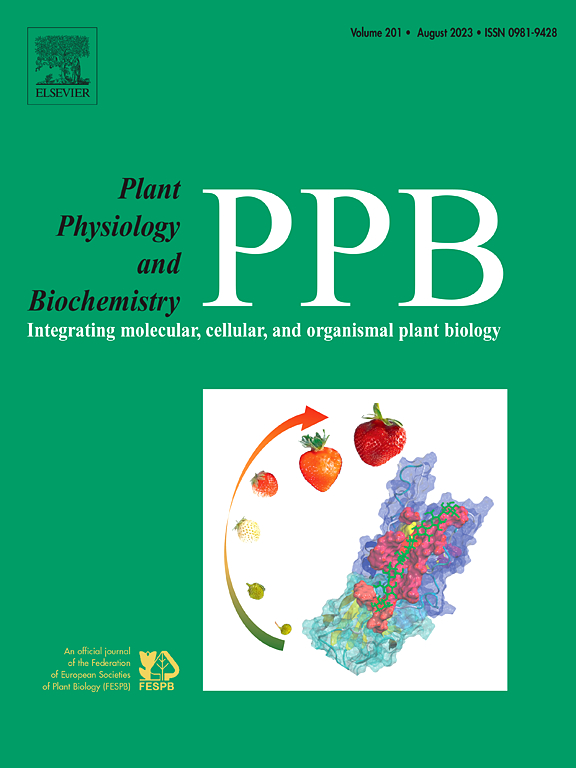外源no介导的microRNA398a-3p -MsCSD2-2模块负向调控紫花苜蓿的抗旱性
IF 6.1
2区 生物学
Q1 PLANT SCIENCES
引用次数: 0
摘要
干旱胁迫是紫花苜蓿(Medicago sativa L.)面临的严重自然挑战,严重影响其产量和品质。NO能提高抗氧化酶活性,减少氧化损伤,是植物应对干旱胁迫的核心机制。小RNA和降解组测序表明,外源NO通过抑制Ms-miR398a-3p的表达来增强抗旱性,该基因直接靶向编码Cu/Zn超氧化物歧化酶(SOD)的MsCSD2-2。烟草中的瞬时共表达实验证实了ms - mir398a -3p依赖的MsCSD2-2转录物的切割。引人注目的是,过表达MsCSD2-2或沉默Ms-miR398a-3p的转基因苜蓿表现出SOD活性升高,ROS积累减少,耐旱性提高。相反,Ms-miR398a-3p过表达加重了干旱敏感性。我们的研究结果表明,Ms-miR398a-3p通过转录后抑制MsCSD2-2作为干旱反应的负调节因子,而NO则作为上游信号对这一途径进行微调。本研究为苜蓿抗旱品种的工程培育提供了可操作的目标。本文章由计算机程序翻译,如有差异,请以英文原文为准。
Exogenous NO-mediated microRNA398a-3p -MsCSD2-2 modules negatively regulate the drought stress tolerance of alfalfa
Drought stress is a serious natural challenge facing alfalfa (Medicago sativa L.), seriously affecting its yield and quality. NO can enhance the activity of antioxidant enzymes and reduce oxidative damage, the core mechanism for plants to cope with drought stress. Small RNA and degradome sequencing demonstrated that exogenous NO enhances drought resilience by suppressing Ms-miR398a-3p expression, which directly targets MsCSD2-2 encoding a Cu/Zn superoxide dismutase (SOD). Transient co-expression assays in tobacco confirmed Ms-miR398a-3p-dependent cleavage of MsCSD2-2 transcripts. Strikingly, transgenic alfalfa overexpressing MsCSD2-2 or silencing Ms-miR398a-3p exhibited elevated SOD activity, reduced ROS accumulation, and improved drought tolerance. Conversely, Ms-miR398a-3p overexpression exacerbated drought sensitivity. Our findings establish Ms-miR398a-3p as a negative regulator of drought responses through post-transcriptional repression of MsCSD2-2, while NO acts as an upstream signal to fine-tune this pathway. This study provides actionable targets for engineering drought-resistant alfalfa cultivars.
求助全文
通过发布文献求助,成功后即可免费获取论文全文。
去求助
来源期刊
CiteScore
11.10
自引率
3.10%
发文量
410
审稿时长
33 days
期刊介绍:
Plant Physiology and Biochemistry publishes original theoretical, experimental and technical contributions in the various fields of plant physiology (biochemistry, physiology, structure, genetics, plant-microbe interactions, etc.) at diverse levels of integration (molecular, subcellular, cellular, organ, whole plant, environmental). Opinions expressed in the journal are the sole responsibility of the authors and publication does not imply the editors'' agreement.
Manuscripts describing molecular-genetic and/or gene expression data that are not integrated with biochemical analysis and/or actual measurements of plant physiological processes are not suitable for PPB. Also "Omics" studies (transcriptomics, proteomics, metabolomics, etc.) reporting descriptive analysis without an element of functional validation assays, will not be considered. Similarly, applied agronomic or phytochemical studies that generate no new, fundamental insights in plant physiological and/or biochemical processes are not suitable for publication in PPB.
Plant Physiology and Biochemistry publishes several types of articles: Reviews, Papers and Short Papers. Articles for Reviews are either invited by the editor or proposed by the authors for the editor''s prior agreement. Reviews should not exceed 40 typewritten pages and Short Papers no more than approximately 8 typewritten pages. The fundamental character of Plant Physiology and Biochemistry remains that of a journal for original results.

 求助内容:
求助内容: 应助结果提醒方式:
应助结果提醒方式:


